HEDS Facilities
LCLS & MEC
The Linear Coherent Light Source (LCLS) X-ray free electron laser (FEL) at SLAC National Accelerator Laboratory is the world’s first X-ray free electron laser to produce hard X-rays and still the only one in the US delivering ultrabright, ultrashort, coherent X-ray pulses to enable studies for revealing fundamental processes in materials. It has a short bunch duration (2-200 fs), full transverse coherence, high repetition rate (120 Hz), tunable from 500 to 25,000 eV with exceptional brilliance (1012 photons/pulse).
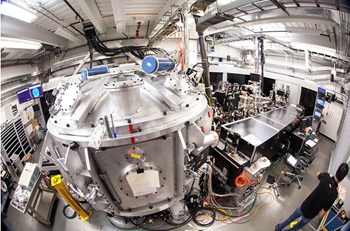
At the Matter in Extreme Conditions (MEC) end-station of LCLS, by varying the short and long pulse laser pulse energies and temporal profile, one can tune the pressure and temperature of the material and probe using a number of X-ray characterization techniques including femtosecond X-ray diffraction and X-ray emission spectroscopy providing a temporal resolution well beyond the current capabilities of DACs and traditional shock techniques. The particular strength of the Matter in Extreme Conditions (MEC) instrument is to combine the unique LCLS beam with high power optical laser beams, and a suite of dedicated diagnostics tailored for this field of science (including an X-ray Thomson scattering spectrometer, an XUV spectrometer, a shielded X-ray spectrometer and a VISAR system). While the large vacuum target chamber makes the end-station very versatile, it has been designed to service key scientific areas including the study of materials in extreme conditions where accurate measurements of the structure, the temperature, and the electrical conductivity are available with unprecedent temporal and spatial resolution.
LCLS X-ray Capabilities
The extreme peak brightness, spectral tunability, spatial and temporal precision, and high repetition rate of the LCLS beam set it apart from other X-ray sources and open myriad new scientific opportunities.
Photon energy to 25 keV. This gives access to Q-values of several tens of Å-1 in wide angle scattering, as well as access to higher-Z materials in terms of absorption depth and available atomic transition lines. The viability of these energies was demonstrated previously using the third harmonic output of LCLS.
Multi-bucket pulse train capability of LCLS, wherein multiple pulses (up to 8) with sub-ns spacing (multiples of 350 ps) up to ~200 ns can be provided with high pulse energy. This allows the evolution of a single irreproducible event to be tracked, without the need to account for random fluctuations between different targets and laser shots.
LCLS self-seeding provides ~10-4 bandwidth with multi-100 µJ per pulse, and orders of magnitude higher spectral brightness than the standard XFEL pulse. Temperature measurements with X-ray Thomson scattering, i.e., inelastic X-ray scattering require the highest possible spectral brightness.
Plasma Diagnostics Methods
Spectrally resolved X-ray Thomson Scattering (XRTS) is a powerful measurement of dynamic structure factor in compressed materials and dense plasmas, and LCLS allows flexible tuning and high repetition rates. The spectral resolution has recently been enhanced by correlating the spectral distributions of the individual incident, non-monochromatized SASE pulses with the corresponding XRTS signals from laser heated plasmas at MEC. These experiments measured plasmons with 1 eV resolution providing information on the dispersion, damping, and detailed balance.
X-ray scattering with meV resolution (meV IXS) allows scattering from ion acoustic modes to infer plasma properties such as sound speed, viscosity, and ion temperature. This ionic feature measurement, recently demonstrated at LCLS, is only achievable with a highly monochromatized XFEL beams.
Wide angle X-ray scattering (WAXS) at MEC provides high quality, precisely targeted and timed diffraction, which has driven many high-impact publications in plasma physics and material science. The 25 keV photon energies allow inferring the pair correlation function (PCF), providing structure factor measurements in materials at high temperatures or with radiation damage regions.
Resonant inner-shell spectroscopy techniques are enabled by the high brightness and tunability of LCLS. These interactions can reveal much about atomic structure. The XFEL can be tuned to resonantly photo pump transitions to excited plasma states that then decay by spontaneous emission, revealing emission lines that would otherwise be below the noise floor and allowing investigation of the atomic energy levels in an extreme matter environment.
X-ray Imaging at MEC takes advantage of the bright, spatially coherent, ultrashort, and tunable LCLS X-ray pulses providing an excellent source for probing dense matter. Several techniques are in use and being explored at LCLS, including phase contrast imaging, ptychography, wavefront sensing, and dark field imaging.
A THz probe generated through optical rectification of the short pulse optical laser has been demonstrated at MEC and combined with diffraction of nanosecond laser driven shocked materials.
Terahertz Laser Laboratory
The SLAC High Energy Density Sciences laser laboratory located at the sector 10 laser alcove of the SLAC linear accelerator is used to (a) conduct experiments relevant to Extreme Matter, (b) develop diagnostics, and (c) develop ambient temperature and cryogenic liquid jets for use in HEDS experiments and for fusion relevant studies (Fig. 2). The lab houses two class 4 amplified laser systems:

- A Thales ALPHA 100 regenerative and multi-pass amplified femtosecond laser system that operates at a maximum repetition rate of 120 Hz and produces 50 femtosecond pulses with energies up to 13 mJ pulses at a center wavelength of 800 nm. Both the regenerative and multi-pass amplifiers of the ALPHA 100 are pumped by a single Thales JEDI laser which produces up to 100 mJ pulses at a wavelength of 532 nm with a duration of approximately <10 nanoseconds.
- A Coherent Astrella regeneratively amplified femtosecond laser system that operates at a maximum repetition rate of 1 kHz and produces 35 femtosecond pulses with energies up to 9 mJ at a center wavelength of 800 nm. The Astrella system has a self-contained pump laser, a Coherent Revolution 80, which produces 45 mJ pulses at a wavelength of 527 nm with a duration <150 ns, as well as an oscillator, a Coherent Vitara S, which produces 800 nm wavelength pulses at 80 MHz repetition rate with an average power of up to 500 mW.
The laser systems can be operated in single-shot mode up to their maximum repetition rate and can be used to produce the 2nd and 3rd harmonics of the 800 nm fundamental wavelength. The laboratory is equipped with a vacuum chamber and hardware for producing the cryogenic and ambient temperature liquid jets, a sample storage unit, and optical tables for building in house diagnostics and optical setups to characterize the jets and measure properties of laser-heated matter.
MeV-UED Instrument
The MeV-UED instrument, part of the LCLS User Facility, is a powerful "electron camera" for the study of time-resolved, ultrafast atomic and molecular dynamics in solid-state and chemical systems. MeV-UED has demonstrated the following properties: high spatial resolution (< 0.5 Å), large momentum-transfer range (0.5 to 12 Å-1), high elastic scattering cross sections, high temporal resolution (< 150 fs FWHM), with the additional benefits of relatively large penetration depths (> 100 nm) and negligible sample damage. These capabilities allow diffraction measurements in Laue configuration from which we infer the pair correlation function and from which accurate structural information can be obtained. These measurements are sensitive enough to resolve radiation damage sites at the 0.1 to 1 dpa level. Further, diffusive scattering measurements have successfully been performed by blocking the Laue diffraction peaks; they have demonstrated strong momentum-dependent electron-phonon coupling in tungsten providing critical experimental data for testing simulations of electrical and thermal conductivity in excited materials. Further, these data have tested inter-atomic potentials used in molecular dynamics simulations for predicting the long-time behavior of materials in extreme conditions.

The following provide detailed parameters of the electron beams and properties of the optical lasers at the MeV-UED facility.
Electron probe parameters:
- Kinetic energies: 2 – 4 MeV,
- Repetition rates: single shot to 360 Hz,
- Pulse charges: 1 – 100 fC,
- Bunch lengths: < 150 fs (FWHM)
- Momentum resolution: < 0.17 Å-1,
- Beam spot size: 100 – 200 mm (FWHM).
Optical laser properties:
- Wavelength range: 800 nm, 400 nm, 266 nm, 200 nm, and 240 nm – 2 mm tunable.
- Pulse length: 75 fs (FWHM)
- Typical pulse energy: > 8 mJ @ 800 nm, > 0.8 mJ @ 400 nm, > 0.08 mJ @266 nm.
- Optical delay: 0 – 3 ns
- Optical spot size: 200 – 1500 mm (FWHM)
Diamond Anvil Cells
In collaboration with Stanford, the SLAC High Energy Density Sciences division has facilities to perform diamond anvil cell (DAC) compression of a wide variety of materials at pressures from 0 to over 100 GPa and temperatures from cryogenic to several thousand Kelvin with XFEL or laser heating. This enables experiments on materials at extreme conditions, as well as the development of novel techniques, such as the high-pressure differential dynamic microscopy developed by the SLAC HEDs group.
The following capabilities are available in house:
- In situ high pressure Raman spectroscopy. Raman spectroscopy probes the vibrational modes of a system and gives insight in phases, chemical reactions, and crystallinity, as well as more exotic effects such as the recently observed mass disorder induced Anderson localization of phonons in ice VII.
- Laser micromachining. The HEDS laser cutter can be used to precisely cut DAC components such as gaskets, samples and couplers for heating to micron precision.
- Optical microscopy. This allows for the visual observation and microphotography of samples at high pressure as well as during preparation.
- Pulsed laser heating. Laser heating of high pressures samples in DACs can be performed with pulses of microsecond to nanosecond duration allowing investigation of kinetic effects as well as reducing damage to diamond anvils during heating.
- Reactive sample handing. There are facilities for handling highly reactive samples, for example group 1 metals such as lithium, in a dry argon glove box.
- Differential dynamic microscopy (DDM). SLAC HEDS were the first to demonstrate DDM at high-pressure in a DAC. This allows wavevector dependent dynamics of compressed liquids and soft matter to be probed and has been used to perform viscometry on super compressed liquid water at various levels of deuteration.
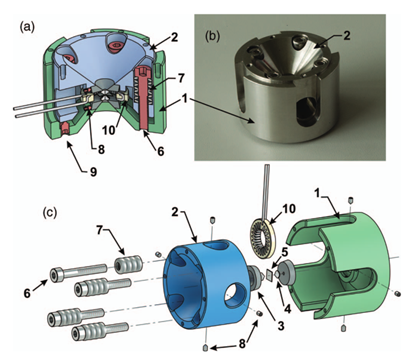
In addition to our in house capabilities we frequently work with X-ray sources such as the Advanced Photon Source, a high brightness synchrotron which allows for in situ X-ray diffraction of DAC samples at a range of pressures and temperatures. SLAC HEDS also frequently use the DAC interaction chamber at the HED instrument at EuXFEL to perform MHz X-ray pump-probe experiments on high pressure materials.
HEDS Laser Cutting System
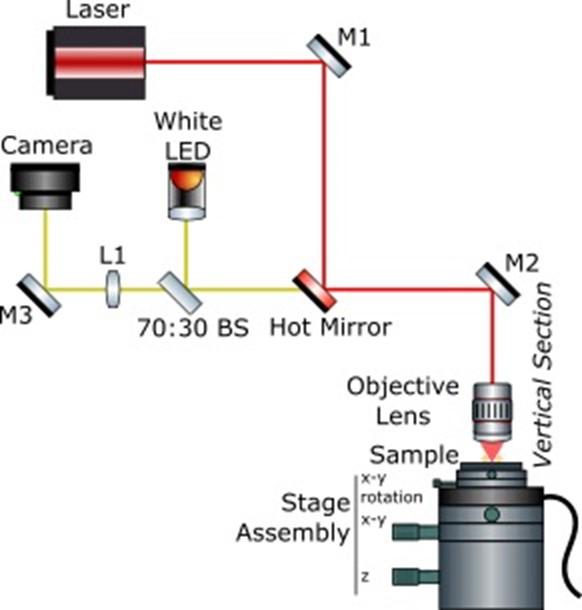
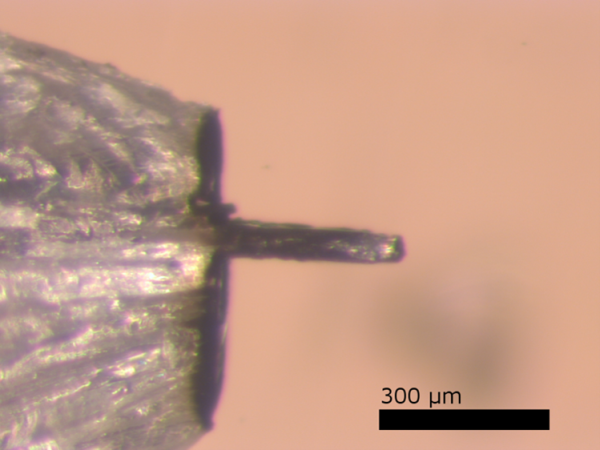
The HEDS laser cutting system allows for micron-precision cutting of a wide variety of thin (up to ~100 mm) materials. This is useful in preparing gaskets, samples and couplers for DAC studies, as well as enabling the extremely precise cutting of targets for laser-driven dynamic compression and other laser-matter interaction experiments. Intense laser target interaction experiments frequently require repeatable conditions such that shots are comparable to gather statistics, compare timings etc. The laser cutter eliminates uncertainty over the target geometry, and additionally simplifies the construction of mass-limited targets which can reduce background noise. The laser cutting system has also been used to prototype other HEDS apparatus, for example water jet nozzles where rapid prototyping aids in development and finalization of designs prior to mass manufacture.
The laser is a class 4 SPI G4 pulsed Nd-glass fiber lasing from 1059-1065 nm and focused to a 5 mm spot with simultaneous microscopy via a camera system allowing observation of the cut material. Pulse duration is variable from 3-500 ns with a maximum pulse energy of 1 mJ and average power up to 20 w (peak power >10 kW). It also has the capability of running in CW mode.
HEDS High Pressure Reactor
The HEDS High Pressure Reactor allows larger volume reactions to be studied to pressures up to 410 MPa. The reaction chamber is 3 ml, orders of magnitude larger than can be compressed in DACs or dynamic experiments. This allows macroscopic volumes of material which was subject to high pressure conditions to be collected and subject to traditional chemical analysis techniques such as NMR.
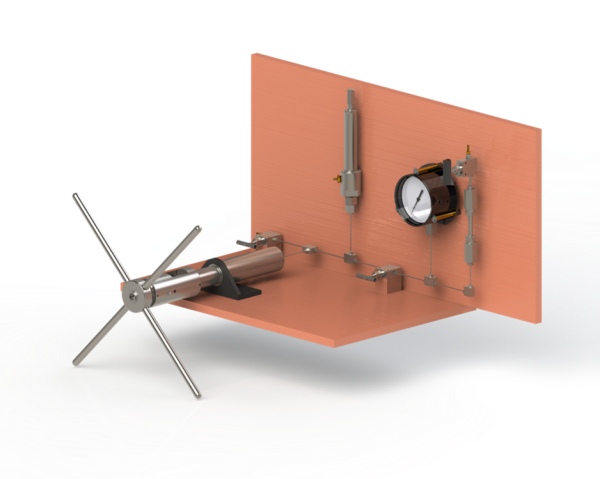
Stanford-SLAC Cryo-EM Center
This facility provides access to state-of-the-art cryo-EM instruments for data collection towards atomic resolution structure determination of biochemically purified single particles and enables scientists across the nation to become independent cryo-EM investigators. Cryo-Electron Tomography (cryoET) is an emerging technique that can resolve subcellular structures in situ with potential to reach sub-nanometer resolutions. Correlated cryo-fluorescence light microscopy (cryoFLM) and cryoET of frozen, hydrated cells can be used to study cellular and molecular functions and dynamics in the 3D context of cells and tissues at a higher resolution than any other imaging technique. For samples which are traditionally too thick for imaging via cryoET, a focused ion beam (FIB) can be used to produce thin lamellae (~100-300 nm) from frozen, hydrated cells containing targets of interest. The combination of cryoET, cryoFLM, and/or cryoFIB along with various other cryoET sample preparation techniques will enable researchers to study macromolecular complexes, at subnanometer resolutions, in their native environment of intact cells. All of these same techniques will be adapted to image thin nanometer structures.
Other Resources at Stanford University
Laboratory for Advanced Materials: The Geballe Laboratory for Advanced Materials (GLAM) is a focal point for the materials research community at Stanford University. Founded 33 years ago, as the Center for Materials Research, it was one of the nine select university laboratories across the nation funded by the National Science Foundation as part of the Materials Research Laboratories program. It brings together researchers from many different disciplines with common interests in materials research.
GLAM offers a broad spectrum of analytical techniques and tools for materials characterization. These include:
- transmission electron microscopy (TEM)
- scanning electron microscopy (SEM)
- electron microprobe analysis (EMP A)
- metallography and optical microscopy (OM)
- X-ray diffraction facility
- thermogravimetric (TGA) and differential thermal analysis (DTA)
- scanning tunneling microscopy (STM)
- scanning probe microscopy (SPM)
- electron spectroscopy for surface analysis (ESCA) equipped with HREELS, XPS, UPS, LEED, SAM, SEM, and quadrupole mass spectrometer capabilities
The TEM, SEM, EMPA, and OM laboratories have complete sample preparation facilities. A special materials laboratory is also available for the cutting, polishing, and grinding of hazardous and toxic materials.
Additional Materials Characterization Facilities at Stanford
Facilities situated in nearby laboratories also provide advanced analytical characterization capabilities, and include:
- nuclear magnetic resonance (NMR) spectroscopy in Earth Sciences
- differential scanning calorimetry (DSC) in Earth Sciences
- Auger electron spectroscopy (AES) and sputter profiling in Electrical Engineering
- high resolution Auger microprobe in Center for Integrated Systems
- nano-indenter in Materials Science and Engineering
- polymer characterization facility equipped with gel permeation chromatography, Milton Roy low angle light-scattering photometry, laser differential refractometry, and mechanical spectrometry located in Chemical Engineering
LAM also accesses an analytical facility at the Stanford Synchrotron Radiation Laboratory (SSRL) that operates a continuously tunable photon beam line with wavelengths ranging from the ultraviolet to soft x- rays. This valuable resource will be used for the characterization of surfaces, thin films, and multi-layer structures.
Shared Nano Facilities: Stanford’s Nano Shared Facilities, including Stanford’s Nanofabrication facility, the Flexible Cleanroom, Stanford’s Nano Center (SNC) and Stanford’s Nanocharacterization Laboratory (SNL) include some of the most advanced nanoscale patterning and characterization equipment available for both ‘hard’ and ‘soft’ materials. These tools allow for fabrication, imaging and manipulation of matter down to the molecular and atomic scale.
Stanford Nanofabrication Facility (SNF): SNF supports a 10,500 ft2 Class 100 clean room that resides within the Paul G. Allen Building, adjacent to the Science and Engineering Quad on Stanford’s west campus. It contains about 100 process tools for semiconductor nanofabrication, including metallization, sputtering, chemical vapor deposition, epitaxial growth, doping, e-beam and optical lithography, dry etching, wet chemical processing, annealing, oxidation, wafer bonding and sawing, scanning electron microscopy, characterization, and testing. While the SNF’s core technology originally focused on fabricating silicon electronics, its ongoing development aims to enhance interdisciplinary research to support engineers, physicists, chemists and biologists in creating a greater diversity of nanostructures from a broader range of materials.
Stanford Nano Shared Facilities (SNSF): SNSF comprises a group of service centers covering Nanofabrication, Electron & Ion Microscopy, X-ray & Surface Analysis, and Soft & Hybrid Materials.
• The Nanofabrication Service Center features two class 100 cleanrooms: the Nanopatterning Cleanroom and the Flexible Cleanroom, both of which reside in the Spilker Building in the Engineering Quad. The former offers a JEOL JBX 6300FS e-beam lithography system that can pattern sub-10-nm features over full 8-inch wafers, a Raith Voyager e-beam lithography system that can write at lower beam energy (10kV/50kV) to avoid damage to 2D materials, an e-beam evaporator, a reactive ion etcher, a NanoSEM, a sputter coater, a profilometer, optical microscopes, wet benches, and a UV ozone cleaner. The Flexible Cleanroom provides standard clean room processes on materials that are incompatible with CMOS processing. Users in this laboratory typically work with smaller chips, crystals, polymers, micro-machined devices, etc. The Flexible Clean Room contains a Durham Magneto Optics ML3 direct write optical lithography system optimized for small chips, a plasma asher used to clean sample surfaces, and fully equipped wet benches. In addition, in the Nanofabrication Center there are an excellent Scanning Electron Microscope for imaging samples and evaluating fabrication results (FEI Nova Nano).
The Electron & Ion Microscopy Service Center resides in the McCullough and Spilker buildings. Featuring advanced scanning electron microscopes, transmission electron microscopes, and focused ion beam tools, it enables nanoscale imaging, milling and compositional analysis on a range of samples. For this proposal, we will use a state-of-the-art FEI 80-300 Titan environmental transmission electron microscope (TEM) for precision characterization of the structure of nanoscale materials. In addition to its usual imaging modalities, the system can also measure electron-energy loss spectroscopy (EELS) and cathodoluminescence with nanometer spot size in a scanning mode. The Titan can be operated at 80 kV accelerating voltage for reduced e-beam induced damage in 2D materials.
- The Soft & Hybrid Materials Facility (SMF, Shriram 099) is situated within the Shriram Building in the Engineering Quad and supports fundamental research on soft materials and their integration with hard materials and devices. It hosts a variety of characterization techniques from differential scanning calorimetry to high-temperature gel permeation chromatography, microRaman optical microscopy, FTIR spectrometry, an AFM for characterizing soft materials, and a surface plasmon resonance system. The SMF provides access to a research facility for analysis and characterization of synthetic polymers, soft materials and polymer devices. Tools include Differential Scanning Calorimetry (DSC), Dynamic Light Scattering (DLS), a Langmuir- Blodgett (LB) Trough Instrument, an Imaging Ellipsometer, a Profilometer, Mechanical Testing Equipment (Instron), and Oxygen Plasma Cleaner, and Impedance Analyzer.
Physics Machine Shop: The Stanford Physics Machine Shop staff can make precision parts from such diverse materials as brass, OFHC copper, and machinable ceramics. The shop charges roughly market rates for these services. Some of the mills and lathes are also available for use by students and postdocs who have taken a training course, and we plan to make use of these for quicker turnaround on simple parts (e.g., for mounting samples, building boxes for electronics, etc.).
